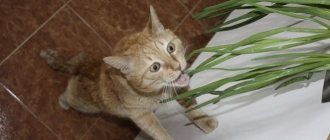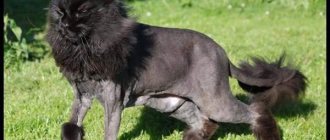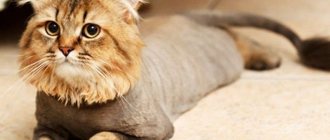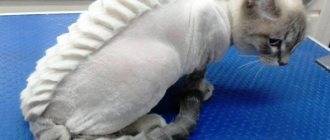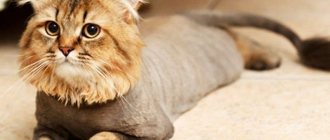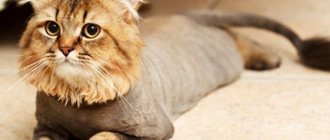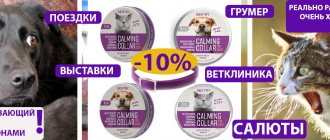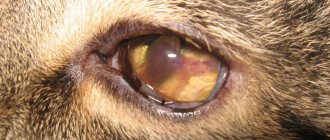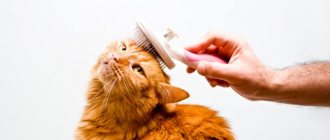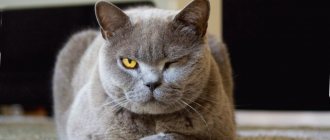Hygienic grooming
Hairdressing and hygiene procedures for animals are the most practical care option, which consists of general cleaning of the surface of the pet’s body, shortening claws, cleaning ears and teeth, combing and cutting off matted fur. Hygienic grooming is relevant for Siberian, Norwegian, Himalayan, Angora and Persian cats, and in addition for breeds such as Maine Coon, Burmilla, Laperm, Selkirk Rex, Munchkin, Highland Fold, Lowlander (British Longhair) and some other representatives of the cat family.
Reasons for the procedure
Hygienic grooming relieves long-haired cats from clogging their stomachs with lint during the molting period, and relieves owners from fluffy deposits on clothes and interior items. The growth and loss of fur in cats is a continuous process, but once or twice a year, when shedding begins, the fur falls out intensively. This is the only inconvenience associated with long-haired felines that hairdressing services can successfully solve.
The reasons for carrying out hygienic grooming in the salon or at home are the following reasons:
- Too voluminous and long hair in the summer or at high room temperatures contributes to overheating of the pet’s body.
- An aged animal cannot cope on its own with maintaining its coat in perfect condition.
- If there are pathologies of the gastrointestinal tract, then ingestion of a large number of hairs by a cat, especially during the molting period, can aggravate its health condition or negatively affect treatment.
- Increased secretion of substances of specific action (secrets) by the endocrine glands.
- Skin diseases, the treatment of which is hampered by long hair.
- Clumped and tangled pile, which is a symptom of various diseases.
- Mats and matted fur.
Pros of grooming:
- No wool deposits on upholstered furniture and clothing.
- It is easier to wash your pet and there is no need to dry it with a hairdryer.
- In summer, the cat does not languish from the heat.
The protests of cat owners who express a negative position regarding visiting pet hairdressing establishments are understandable. And they are based, first of all, on the fear of harming a defenseless creature. But you need to approach any event sensibly: if you eliminate all possible risks when carrying out grooming, then if the need arises, you can do a pet haircut.
Minuses:
- Stress for a pet that is unaccustomed to interference in its life from strangers.
- Possible abrasions on the cat’s body if hairdressing manipulations are performed by an unprofessional master.
- Undesirable consequences of using anesthesia in case of an allergic reaction.
To cut or not to cut
It is important to understand that not all cats can and should be subjected to this procedure. So the following are a kind of contraindication:
- colorpoint and tipping colors - as the fur grows on the back and belly, it will become several tones darker than before cutting;
- disgusting character and violent temperament, when the animal does not give in to any persuasion. Of course, you can cut it under anesthesia, but in this case, evaluate all the possible risks associated with the administration of narcotic drugs: cardiac arrest, coma, failure of the liver and kidneys. As a last resort, sedatives and muscle relaxants are used instead of drugs, but only after approval of the appropriateness of their use by a specialist and under his clear guidance;
- Without an urgent need, there is no point in cutting short-haired cats - the heat does not particularly interfere with normal life activities, and they never have mats;
- Smooth-haired animals are cut only in extreme cases, for example, when they have been worn in oil paint and it is easier to shave the animal than to try to rub off the matted multi-colored wool.
Salon or home haircut?
The question of whether to contact a specialized office or trim the pet’s fur themselves arises among owners very often. There are quite a lot of arguments in favor of both options. Grooming cats at home is much cheaper, and many mustachioed purrs perceive trips to the salon as very stressful.
The difficulty is that not all animals tolerate grooming calmly. Some people so actively resist attempts to cut their hair that they have to be sedated. Most often, mild muscle relaxants are used in this capacity: these medications do not completely immobilize the cat, but reduce activity and make all its reactions more inhibited. Only a professional can choose the right medicine, give the correct injection and monitor the condition of the four-legged patient.
Even choosing a shampoo for bathing before a haircut sometimes turns into a difficult task. An incorrectly selected grooming product can damage the coat, cause allergies or skin irritation, and in the worst case scenario, even cause the animal to go bald.
Additionally, cat grooming varies greatly in difficulty. Hygienic or the simplest of model haircuts, such as “lion”, “puma” or “puss in boots”, can be easily done at home. Others, more complex ones, can only be done by a specialist. Thus, it is often much easier to pay for a trip to a clinic or salon. Usually a groomer gives a cat a haircut in an equipped office, however, a home call is quite possible.
Animal clipper
Grooming a cat at home: what will you need?
If you still decide not to go to the salon, then keep in mind: grooming cats is not the easiest task. You will need a lot of patience and some tools:
- Hair clipper.
- The attachments for it are at least 3 mm long (it is best to use veterinary attachments No. 3 for these purposes).
- Comb-comb.
- Regular or hairdressing scissors (if you want a “designer” hairstyle, you can take both regular and filer scissors).
- A high table or ironing board at which you can work comfortably.
- Just in case, prepare hydrogen peroxide and cotton wool.
And, of course, you need to take into account that for such a procedure you will need an assistant, or better yet two. After all, most animals perceive attempts to cut their hair very aggressively, and someone will have to hold the wayward cat so that she does not injure her “hairdresser.”
Place your pet on the tabletop, holding him by the front and back legs so that he cannot twitch. Carefully trim the fur first on the back, then on the belly, paws and tail. If necessary, trim any stray hairs.
After completing the procedure, be sure to bathe the animal to wash off any remaining hair on its skin.
Professional groomer kit
Choosing Cat Grooming Tools
The haircut can be carried out using scissors (medium size, sharp with rounded ends) or a clipper, preferably silent, so as not to frighten the pet. The latter method is more effective and safer - there is practically no possibility of injuring the animal, and the result is guaranteed: a uniform haircut with the ability to choose the desired length of fur.
Auxiliary tools:
- soft comb;
- textile;
- hydrogen peroxide or chlorhexidine (needed if you injure an animal);
- toys and treats;
- table (or other surface).
It is better to immobilize the cat during the procedure. For example, wear a special collar. It is better for the second person to hold the cat and calm it while the first haircut is performed.
If the animal is very aggressive, it is better to visit a veterinary clinic. In some cases, anesthesia may be needed. It is worth doing it only if there is no other option. For example, a cat is covered in tangles and it’s hard for him.
Application
An aqueous solution of formaldehyde (methanediol) stabilized with methanol - formalin - causes denaturation of proteins, so it is used as a tanning agent in the tanning industry and tanning gelatin in the production of film. Due to its strong tanning effect, formaldehyde is also a strong antiseptic; this property of formaldehyde is used in medicine (Formidron, Formagel and similar preparations) and for the preservation of biological materials (the creation of anatomical and other preparations).
Formaldehyde is used as a fumigation agent, in particular during the storage and transportation of grain.
An aqueous solution of formaldehyde (methanediol) stabilized with urea - KFK - is one of the most important sources of formaldehyde and urea in the production of urea-formaldehyde, melamine-urea-formaldehyde resins and for the treatment of urea against caking; used in the woodworking and furniture industries for the production of plywood, chipboard, etc.
The main part of formaldehyde is used in the production of thermoset polymers (phenol-formaldehyde, urea-formaldehyde and melamine-formaldehyde resins); it is also widely used in industrial organic synthesis (pentaerythritol, trimethylolpropane, etc.).
During storage (at temperatures below 9 ° C), the formaldehyde solution becomes cloudy and a white precipitate (paraformaldehyde) precipitates.
Registered in the food industry under code E240.
How much does grooming cost at a salon?
If you are still afraid to trim your cat, or for some reason you cannot do it yourself, then today there is an opportunity to leave this task to an experienced specialist - a groomer. The cat groomer has professional grooming skills and will do everything in the best possible way. Your pet will not have time to get scared or nervous. As a rule, such people love animals, and they, in turn, feel this.
Grooming services can be ordered in two ways. The first option is to go to a cat salon yourself. All necessary equipment and tools are available there. But if your cat is very sensitive to the environment, then you can invite a specialist to your home. The pet will feel more confident and calm in such an environment.
At the same time, it is worth understanding that grooming domestic cats in a salon can be quite expensive.
Haircut cost by city
- In Moscow and St. Petersburg, grooming can cost from 1100 - 1200 rubles.
- In Krasnodar, Nizhny Novgorod, Tyumen, Yekaterinburg, Kazan and other cities, a standard cat grooming will cost from 1,500 rubles.
- In Kiev, Kharkov, Lviv, the cost of a cat's haircut will be in the range of 200 - 600 UAH.
- In Minsk, grooming salons offer to trim your pet for between 30 and 200 Belarusian rubles (depending on the size of the cat).
Those owners who want additional grooming services will have to pay extra. For example, in Russia you have to pay an extra 400 rubles for combing out mats, 300 rubles for cutting out mats, and there is a separate cost for trimming claws, treating ears and eyes, and trimming hair between the toes.
Salons that care about their image and authority always offer discounts to regular customers. In some cases, the price for grooming in Moscow can be reduced by up to 50%.
Manufacturers
The range of tools for grooming cats is quite extensive. The cost varies depending on the brand, purpose of the tool, and material.
Scissors should be easy to use and maintain.
Scissors from the brands Zolux (France), Ferplast (Italy), Trixie (Germany), Witte Rose Line (Germany), Geib Buttercut (USA) have proven themselves well in the household and professional spheres.
The tools from these brands are easy to use and suitable for home care.
Professional scissors are made of durable materials - stainless steel, with an additional titanium coating and therefore will last a long time without losing their qualities.
Instrument care
Thanks to the use of high-quality materials, professional line scissors do not require special care.
However, general rules for maintaining metal tools should be followed.
- Scissors should be stored horizontally. The ideal place for storage would be a special case, lined inside with suede or soft fabric.
- Before starting work, you need to check the tension of the sheath if the screw is adjustable.
- After use, scissors (but not cutting blades) should be wiped with a piece of soft cloth using a small amount of oil (special).
- Shearing scissors should only be used for cutting wool, and not for cutting flowers, paper or other materials.
Silent Scaredy Cut scissors do not require special care. They were originally designed for home use, so maintenance is kept to a minimum. Stuck hairs can be brushed off with a brush or rinsed under running water, then wipe the instrument dry.
Some manufacturing companies stipulate that the blades of their products do not become dull for a long time. But if the question of sharpening still arises, you need to contact a specialist. You should not try to sharpen the tool with improvised means, as this may render the scissors unusable.
How to trim a cat's hair at home: instructions
Below is the sequence of actions that you need to follow:
First of all, shorten your cat's claws using special pliers. Tools should be disinfected first. Afterwards, lightly press on the pet’s paw pad and carefully and at the same time quickly remove the claws without touching the skin. Thanks to this, you will be able to protect yourself from pet aggression and scratches during a haircut.
If the haircut is being done for the first time, it is advisable to use the help of a second person who will gently hold the cat from the sides. Some animals will behave quite aggressively. For such individuals, veterinary clinics sell special plastic collars that allow you to fix the cat's head in one position and prevent it from biting. As for the limbs, you still have to hold them.
After the animal is laid on its side and its paws are securely fixed, the machine can be used. Start removing hair from the sides, being careful and leisurely.
If the cat feels the owners' anxiety, it will also experience stress and begin to break out and scratch. After the sides, you need to move on to the back and stomach. Particular attention is paid to cats with mammary glands: if you use scissors, it is important not to injure this sensitive area, so try to relax the animal as much as possible. You can move both with the growth of the fur and against it.
- It is recommended to remove the remaining hairs with small scissors, since sliding the machine over the animal’s skin is not worth it: this causes discomfort and microtrauma.
- During the procedure, lightly pull the animal's skin, especially if the cutting is done with scissors. This will prevent cuts.
- At home, the tail and paws are usually left untouched, but if you wish, you can shave the hair off the tail with a clipper, leaving a small brush at the end (this is an excellent option for show breeds).
At the end of the procedure, the cat should be washed in warm water; if desired, a small amount of mild animal shampoo should be added to the water. Next, the pet is dried with a hairdryer, which is set to the most silent setting.
What should you use to cut your hair with - a machine or scissors? If you want your pet to look really attractive and neat, it is recommended to alternate the use of scissors and clippers. With scissors, you simply trim what the automatic device could not remove. Grooming long-haired animals exclusively with scissors will be long, dangerous, and the result may not be neat enough.
Is it possible to cut wet wool? If you use a machine, it can be used on dry animal skin. Decided to make do with scissors? In this case, it is recommended to slightly wet the fur and comb it thoroughly: this way it will be easier for you to remove unnecessary hair. Regardless of the breed, you should not cut the animal too short (it is better to leave a couple of millimeters of fur). Thanks to this, you will ensure normal thermoregulation and, in addition, avoid injury to the skin.
The process of cutting a cat with scissors
To groom a cat at home, it is important to have someone help hold it for the first time. The cat is placed on its side and its limbs are supported. You can use a plastic collar for safety.
Before the procedure, it is important to disinfect the instrument with alcohol so as not to infect the animal in case of injury.
Using scissors, you should immediately cut off tangles and any areas of matted fur. Then proceed directly to the haircut:
- The head is treated. Usually the head is not cut bald, leaving a fluffy hairstyle, but it is better to immediately trim off the excess overgrown strands and hair. It is important not to touch the whiskers, but it is better to remove the “whiskers” - it will be easier for the pet to eat and keep clean.
- Remove excess volume from the body, neck and behind the ears, paws and tail.
- Pay special attention to the intimate area; it is important not to damage these areas with scissors.
After finishing, you should wash the cat and dry it thoroughly with a hairdryer, removing excess hair.
Why cut your cat's hair?
After clipping, the coat is easier to comb.
In fact, the procedure is quite popular and in demand in grooming salons. Yes, there are owners who bring their favorite furry dogs for a haircut for the sake of winning an exhibition, an extravagant look and cool, cute photos for Instagram or social networks.
But there are also those who know that such hairstyles have many advantages for the health of their children. What are the advantages of a unique hygiene procedure:
- getting rid of tangles, which have become too numerous and can no longer be untangled with ordinary brushes;
- normalization of digestion: unsightly and hanging hairballs, disfiguring the cat, can cause blockage of the stomach and intestines if accidentally swallowed during another lick;
- order in the house: after a haircut, the wool does not lie everywhere and does not cause the owner to have bouts of quiet rage when, once again, black pants have turned into a shaggy hedgehog;
- easier combing;
- peace of mind between the cat and the person: you won’t have to tyrannize your pet and freak out from the daily tearing apart of tangled areas of fur;
- relief from suffering: in summer the animal will no longer suffer from the heat.
By the way, the presence of tangles is the cause of dermatological problems: the skin under them heats up more, creating favorable conditions for the development of pathogenic microflora. The frequent formation of “felt balls” indicates a metabolic disorder or vitamin deficiency and requires consultation with a specialist.
Cat hairstyle trends: which haircut to choose?
If you just need to shorten the coat, this is a simple task. But there is a choice of different curly haircuts, which are chosen taking into account the type of coat, thickness, and breed of the animal. This is a very important factor for winning at the exhibition, because it provides the original appearance of the pet and reflects its individuality.
The following hairstyle options are relevant today:
- “lion”: the entire back and the upper side of the legs are cut, the tail at the base. At the same time, the head is left untouched, as is the neck - a kind of “mane” is formed, as is the tassel at the tip of the tail. The tail can be shaped like a pom-pom, Christmas tree, or panicle. You can achieve the squirrel tail effect. The “socks” on the feet are made short or in the form of “gloves”.
- “puma”: performed similarly to “lion”, but the shirtfront is left in the chest area, which looks beautiful;
- “dragon”: cut the sides and belly until smooth, leave the fur along the ridge and tail, give it the shape of a fluffy comb with incisors;
- “Puss in Boots”: repeating the image of a fairy-tale hero, the hair on the back is cut short, the paws are cut off from above, so that there are neat and identical “boots” below.
There are other models of hairstyles, but they are more complex to perform; it is better to entrust them to groomers. This is the so-called “continental” haircut, “modern”, “harlequin”.
We hope that this guide will help you successfully and tastefully decorate your favorite cat's fur. By following all the above recommendations, you will know exactly how to successfully trim a cat with a clipper at home and create an aesthetically pleasing appearance for your pet.
Grooming with the help of a veterinarian
At home, cats often become, if not masters, then full members of the family. They perceive attempts to give medicine, trim claws or examine teeth negatively, running away, dodging or attacking the person. Similar behavior is observed when cutting hair. The animal hides in inaccessible places and attacks scissors or a machine.
In the veterinarian's office, your pet's behavior changes. Some are violent, but many resort to verbal resistance. That is, by continuing to howl and growl, the cat allows manipulations, such as injections and haircuts.
Hair styling is one of the services offered by animal clinics. It is quite expensive (comparable to minor, non-cavity surgery) and may involve anesthesia. The latter poses a risk to the life and health of the pet. On the Internet you can find reports of cats put into hibernation while their fur was being groomed, but which never woke up.
A professional machine, available in most offices, will quickly remove excess hair. In this case, the owner can use the tool himself while the veterinarian holds the cat - specialists are better at this task.
Distract or tire your pet
Do you want to know how to calm a cat down for a haircut? His favorite toys can help with this. Animals of both sexes may be attracted to pillows, soft toys, large spools of thread, and other objects. During the grooming process, these objects serve as “passive” entertainment - the pet does not chase them around the house, but clasps them with all its paws, simulating a fight.
The animal fixes the object it likes, paying little attention to the environment and the manipulations that are performed with it. The choice is yours to decide how to calm your cat before grooming.
In this state, the animal will allow you to trim not only its fur, but also its claws. The main thing is to monitor changes in your pet’s behavior. Eventually he may get tired of it and begin to show aggression towards the hairdresser.
Not wanting to affect the psyche, the owner can try to exhaust the pet in order to reduce the negative reaction to the haircut. For example, feed generously or have an active play session lasting at least 30 minutes.
After waiting 15-20 minutes after the cat lies down to rest, you can approach with scissors or a clipper. A tired animal may be more loyal to the procedure for some time. But this approach to cutting will require several stages - even with a clipper it will be difficult to cut off all the wool at once. During this time, the pet can also get used to the tool and begin to react less to it.
Immobilize or sedate
It is not recommended to use anesthesia and sleeping pills to create a hairstyle, but you can use more gentle drugs. Herbal-based products, like Kota Bayun, are suitable. But you need to start giving them at least a week before the procedure - the drug must accumulate in the body.
When choosing how to calm your cat before grooming at home, it will be more effective to use physical remedies instead of over-the-counter medications. By holding a cat by force, you suppress his will, thereby risking causing him depression or a nervous breakdown. Although such actions can radically stop aggression.
For cutting, it is recommended to hold the cat by the scruff of the neck. According to one version, the animal calms down, remembering how his mother endured him like this in childhood. The restrained pet is laid on its side and the hair is cut off - a job that, according to the Internet, can be done by one person. In reality, stupor when the scruff of the neck is grabbed does not always occur - the animal may continue to struggle.
A greater likelihood of success will be ensured by working in pairs: one person immobilizes the pet’s paws, lying on its side, the second person cuts the hair, additionally holding the body. But in this case, the cat often shows more aggression, offended by the “group attack.”
A compromise option is to cut your hair yourself using a bell collar. Plastic will prevent your pet from biting, and the absence of extra hands will make you less nervous. If the animal struggles too actively, you should stop working so as not to injure it with the cutting tool or damage the limbs.
It is better to ask a specialist for help or postpone the haircut to a time when the pet is calmer. Cats rarely agree to voluntarily give up their fur, even if it would benefit them.
You can try to calm the animal by moving it to a stressful hospital environment or by redirecting its attention to a toy.
In any case, it is better not to manipulate scissors and the machine alone. Since there is a chance that you will not hold the cat and it will get hurt trying to free itself from you and run away.
Do you know how to properly trim a cat's claws?
Adviсe
Before deciding to groom your cat, you need to take into account the recommendations of experienced professionals. Thus, professional groomers advise, if possible, not to touch the tail, which is the most vulnerable part of the animal’s body.
Even minor damage to it causes enormous suffering to the pet and can negatively affect the cat’s overall well-being. You should also pay attention to the stomach, especially the lower, most tender part.
The next point that experts advise you to pay attention to is the psychological preparation of your pet. This procedure may require some time and patience from the cat owner.
So, long before the planned haircut, you need to start accustoming the animal to the table. This should be done very carefully and consistently.
To begin with, simply place the cat on the work surface, stroke its sides and back and, if possible, try to lay the pet on its side without stopping stroking. After the animal stops behaving warily on the table and responds happily to caresses, they carefully begin combing, each time increasing the time of the procedure.
If you are consistent and do not forget to regularly brush your cat on the table, then over time she will get used to the procedures and will perceive both the table and the comb quite calmly. The next important step will be to accustom your pet to the sound of a running machine. Ideally, it is better to purchase a silent device, but if this is not possible, then you can try to accustom the cat to the noise of a running electric motor. To do this, a few days before the haircut, you should turn on the clipper for a short time, while holding the pet in your arms and stroking it.
In general, grooming a cat should be perceived as an extremely last resort when the animal’s fur is hopelessly neglected and it is not possible to comb out the tangles. As for haircuts for decorative purposes, in this case it is necessary to be guided by the cat’s reaction to the procedure, while assessing the possible consequences. When performing complex show hairstyles, it is recommended to give the cat a rest and trim it in 2-3 stages.
It should also be remembered that a trimmed mustache, as well as hair inside the ears and on the head, significantly reduces the sensitivity of the smell receptors. There is no need to groom overly aggressive or overly active pets yourself. It is better to take such animals to an experienced groomer, where sedatives may be required. Thus, each owner must decide for himself whether to cut his pet’s hair or not. To do this, you need to soberly assess the benefit/harm ratio and focus primarily on the well-being and mental balance of your pet.
To learn why cats need to be groomed, watch the following video.
Why do they get a haircut?
There may be several good reasons why grooming a furry animal is necessary.
Hygienic haircuts are performed when the animal’s fur is tangled or tangled. Also, quite often pets can get very dirty. Since not all dirt can be washed off with regular shampoo, you will have to resort to cutting the fur. For example, if the cat got into the paint or got dirty with building materials (glue or cement). Sometimes owners of old or sick animals are forced to resort to hygienic grooming. After all, such cats may not be able to care for their fur.
Recommendations from experts
The procedure for grooming domestic cats is a last resort; as a rule, it is resorted to due to the systematic formation of mats or the need for treatment based on medical indications. In most cases, animals with long hair undergo a similar process.
To prevent pets from getting tangled, it is recommended to comb them with special devices: a slicker brush and a furminator. In addition, animals need to be washed using high-quality products that help maintain the well-groomed condition of their “fur coat”. Such actions not only have a beneficial effect on the health of animals, but also relieve their owners from scraps of fur scattered throughout the house.
You should know that if someone in your household is allergic to a pet’s fur, cutting the pet’s fur will not help. This is explained by the fact that in this case the reaction of the immune system is caused directly by the skin secretions of the animal, as well as by its saliva preserved on the hair.
The coat of cats belonging to semi-longhaired breeds not only protects them from the cold, but also prevents overheating. This type is not inclined to form tangles and only needs regular bathing and combing. This applies to species such as Maine Coon, Norwegian and Siberian cats.
Persian breeds have thin and delicate fur, which after shearing is restored much easier than that of their counterparts. Persians have a very difficult time withstanding hot weather , so their coat is often shortened.
Where to cut a cat's hair in Moscow
To perform a hygienic or model haircut, you need to go to a beauty salon for animals. There are a large number of professional hairdressing salons and private hairdressers in Moscow. The advantage of grooming cats in a salon is that professional establishments are equipped with everything necessary to perform hairdressing and beauty services. But they have their drawbacks: a noisy road with many unfamiliar faces, a foreign environment, unusual procedures - this complex of unfavorable factors can affect the mental state of the cat.
The advantages of grooming cats at home are obvious: saving time and effort for the owner, as well as nerves for the pet. An animal at home behaves much calmer, due to the fact that everything around is native, there are no foreign smells and sounds. The only disadvantages include the inability of the master to carry professional equipment with him, but only hairdressing tools.
In the cabin
In the capital's hairdressing salons for animals, in addition to grooming, they provide a wide range of services to improve the appearance of your pet. Moscow salons are equipped with modern specialized equipment, tools and supplies for grooming of any complexity. But while a person who comes to an establishment will definitely appreciate the professionally designed and beautiful interior, then for many representatives of the feline breed any unfamiliar environment causes stress. Considering this circumstance, for particularly impressionable cats it is better to invite a specialist to your home.
Professional haircut at home
Grooming long-haired cats at home is especially in demand among residents of megacities due to constant employment. Specially trained groomers are able to find contact with any pet, making the procedure for trimming a cat at home quick and easy. The owner will only have to clean up the cut hair from the floor and console his mustachioed four-legged friend with something tasty.
Precautions when cutting
When choosing a hair clipper at home, preference should be given to models that operate on mains power. You should not purchase them with a small blade to avoid injury; the minimum length is 0.5 mm.
It is important for the owner not to worry during the haircut, otherwise his anxiety will be passed on to his pet.
Avoid overheating the machine.
For long-haired cats, using scissors is ineffective.
To ensure normal thermoregulation of the animal, it is recommended to cut the hair not too short.
Reasons for cutting a cat's hair
There are several good reasons why pet grooming is necessary and desirable.
procedure. According to their purpose, haircuts for domestic cats are:
Hygienic. This procedure is carried out if the wool is tangled and tangles have formed in it. Often the animal can become very dirty. Contaminants such as paint, varnish, building materials (plaster, cement, glue, etc.) cannot always be removed with water and shampoo. In this case, only trimming the wool will help.
In some cases, hygienic haircuts are resorted to in old and sick animals that are unable to care for their coat. This hairdressing procedure is performed to avoid the formation of hair balls in the stomach. This is especially important during hot periods to avoid overheating of the animal.
With prolonged molting, such a hairdressing procedure can make it easier to maintain a pet.
Medicinal. A veterinarian can prescribe a haircut for certain diseases. Indications for the procedure are the following diseases: parasites (fleas, lice), dermatitis, infectious skin diseases, hyperplasia of the sebaceous glands). Clipped wool makes it possible to more effectively treat the skin with medications and significantly reduces treatment time. There is nothing complicated about how to shave a cat for medicinal purposes.
Decorative or fashion haircuts. This type of hairdressing in relation to a domestic cat is a whim of the owner, nothing more than a tribute to fashion. Through an original haircut, the owner expresses the characteristics of the cat's character, disposition, and individuality.
Exhibition. A special haircut that is carried out to give the animal its shape to breed standards.
The best quality haircut is, of course, done in a salon. Grooming specialists use special tools and devices that do not damage the skin. But it will be useful for the owner to know how to cut a cat’s hair at home, so as not to overpay every time.
To see how cats are cut in a salon, watch this video:
How does haircut affect animals?
Is it possible to cut a cat's hair without causing any changes, and how will cutting it at home affect the pet's behavior?
Haircut significantly affects hair growth
Almost all long-haired breeds change coat color, becoming darker or lighter. It happens that haircut significantly affects the growth of fur, sometimes this process accelerates, and in some cases, on the contrary, it becomes slower, and in rare cases it stops growth completely.
Reasons and frequency of haircuts
Cats need to be trimmed from time to time for several reasons. Most often, this activity should be carried out with animals that have long hair, due to its constant rolling into clumps, which cause numerous inconveniences. Cat haircuts can have different purposes:
- For hygiene purposes. In this case, the process is necessary due to the wool becoming tangled and matted. The animal may get too dirty, and the type of contamination will be paint products or certain building materials that cannot be removed with shampoo.
- In certain situations, the fur of very old or sick cats that are unable to take care of their “fur coat” is shortened. This procedure prevents the formation of hair balls in the stomach, which often cause intestinal blockage. It is also necessary in conditions of elevated air temperatures, when there is a risk of overheating of the pet.
- Due to prolonged molting. In this case, cutting will make keeping the animal much easier.
- For medicinal purposes. For certain diseases of cats, haircutting may be recommended by a veterinarian. Indications for such a procedure are usually infectious skin diseases, dermatitis, the appearance of various parasites, as well as hyperplasia of the sebaceous glands. Trimmed wool makes it possible to treat the skin with medications more effectively, and this significantly shortens the treatment process.
- Decorative haircuts. Such hairdressing services for pets are nothing more than a whim of their owners. With the help of a model haircut, owners try to emphasize the individuality of their pet and the characteristics of its character.
- Exhibition haircuts are designed to demonstrate the standards of their breed in animals.
The frequency of procedures associated with shortening hair depends on the intensity of its regrowth. This usually takes from three to six months, depending on the breed of the pet, its health condition and age. On average, it is recommended to provide cats with such hairdressing services no more than two or three times a year.
Removal of tangles should be carried out as they appear.
Model haircuts can be performed more often, but in this case the health of the animal, the condition of its coat, and the season of the year should be taken into account. Therapeutic and hygienic haircuts are usually carried out as needed.
